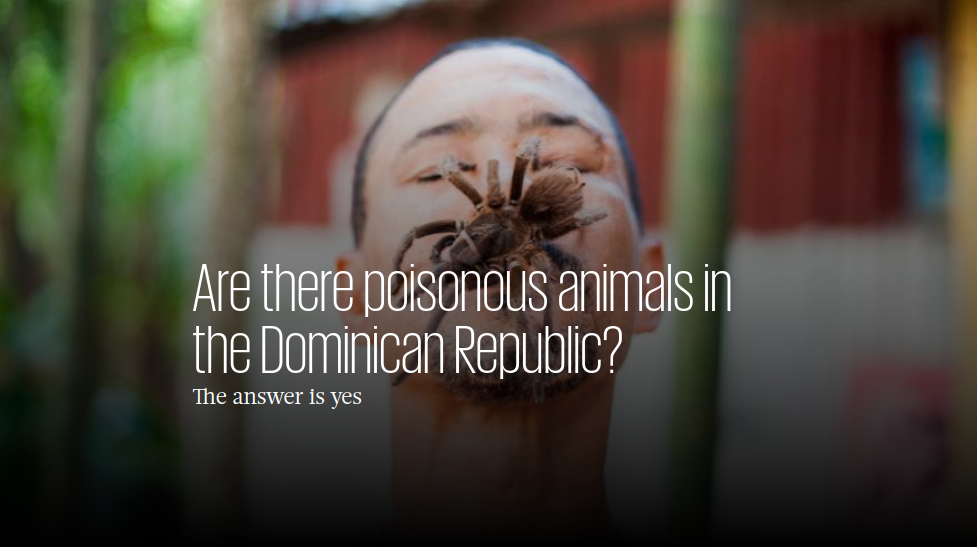Poisonous animals of the Dominican Republic

Marvin del Cid
with additional notes by
Renn Loren
In Dominican popular culture, it is often said that there are no poisonous animals in the country. If we compare ourselves with regions of the continent, such as the deserts of North America, the Central American jungle or the Amazon, this island does not represent a higher risk for human beings when they interact with nature.
But this does not mean that there are no poisonous animals on the island. It should be noted that poisonous does not mean lethal, but it can mean very painful. But certain conditions can complicate a sting and even be life-threatening, such as an anaphylactic shock, or severe allergic reaction, even from a bee sting.
This list is not intended to be a “ranking” of danger, nor cause nightmares for anyone who reads it.
Here we expose some of the animals that possess venom both for hunting and for defending themselves, some of them being excellent pest controllers.
Among our biodiversity, we have a rarity of nature. The extraordinary solenodon, a living fossil that has two hollow teeth from which it injects poison to hunt and fight with others of its kind. It shares this characteristic only with the male platypus and the short coloa shrew.
One of the most painful stings on the beach is that of the stingray which uses its stinging barb when it is stepped on. The barb harbors a poison that causes intense pain that progresses slowly through the body and can last for hours.
The rarely seen runner snake, an endemic reptile that despite its cobra-like appearance, when it shows its hood, is not dangerous to humans. Although it can inject poison, it is difficult for this to happen because its fangs are located at the back of the jaw. This species has bitten the biologist Robert Ortiz 4 times and many of his colleagues, without having managed to inject its poison.
The venom fatalities of some species depend more on complications or lack of treatment, such as the black widow’s bite, the violin spider (Brown Recluse) and the rare Portuguese man o’ war.
We consult biologists and scholars to get a quick list of some species that have venom, from skin discomfort to possible death due to complications.

15. Cassiopeia and aguaviva
The marine jellyfish are pelagic, with a jelly-like body in the shape of a bell or umbrella. Cassiopeia is also known as inverted jellyfish. Regularly found on the bottom in shallow waters and mangroves, their sting may go unnoticed as a discomfort in the skin that disappears soon. On the contrary, the species of jellyfish with tentacles, the toxicity of their sting varies according to the species. The sting can be painful with a burning sensation.
The toxicity of the jellyfish sting varies by species. Most jellyfish found by bathers cause painful and burning sensations, but temporary.

14. Mamp Pempén, Rhinella marina
Also known as the cane toad, it was introduced from Central America to the country as pest control in cane plantations. It has glands behind the eyes and back that secrete a potent toxin if it feels threatened. Lethal to predators and the human being only if ingested. Wash your hands thoroughly if you handle them, and you will have NO problem!

13. Horse wasp, Polistes major major
In the Schmidt index of pain from insect stings, ranging from 1 to 4, it is in position one being the lowest on the scale. Yellow and black are not aggressive, but usually, attack defending the nest or if they feel threatened. Unlike the honey bee that only stings once, this wasp can repeatedly sting in a single attack.
Many times humans are stung when they pass near a nest without realizing it. So keep your eyes open and be aware of your environment. And that’s a great habit in any case!

Scolopendra gigantea
12. The centipede, Scolopendra gigantea
The centipede is a chilopod and found everywhere in the world. There are more than 3,000 species worldwide. They are carnivorous and to capture their prey, they have developed oral pincers that secrete poison. These pincer-fangs can measure about 25 cm long.
A centipede bite is usually excruciating, causes swelling and redness, located at the site of the bite, but does not cause significant damage.
They can be found in many deserts and nearly all tropical regions throughout the world in dark, moist places – under rocks, broken concrete, logs, tree stumps. Keep your eyes open and avoid them, and all will be fine.

11. Solenodon, Solenodon paradoxus
Endemic nocturnal mammal of the island, a genuine living fossil. Unlike the male platypus, which has venomous spurs in the hind legs and some shrews that have toxic saliva, the solenodon is the only one capable of injecting poison through specialized hollow teeth, in the style of snakes.
He uses it to hunt insects and when fighting with other males. The venom is not lethal in humans, but it can cause a lot of pain and easily infect the wound. Chances of seeing one are rare, chances of being bit are rarer still. You would have to pick it up. And how likely is that?

10. The spider cocoa, Phormictopus cancerides
The Hispaniolan giant tarantula is an arachnid native to the Caribbean. Although it can shed stinging hairs from its abdomen to keep predators away, it uses its sharp fangs almost exclusively for hunting, injecting venom into the prey that paralyzes it and breaks down the tissue. The bite is painful, although, in humans, it can be a dry bite so as not to waste its poison and is not generally harmful. They would instead run than fight so leave them be, and you’ll be fine.
They are docile, non-aggressive, and make excellent pets if one knows how to care for and handle them.

9. Scorpion
Forty-four species of scorpions are known on the island of which 42 are endemic.
It is easy to find nocturnal habits under leaf litter, stones, hollow logs, and hidden in houses, in dark areas. They have a sting with poison at the end of their tails that they use to hunt and defend themselves. The sting in humans, of our species, is not fatal but can be very painful and does not require treatment. The pharmaceutical industry studies its poison as it has many beneficial medicinal properties.

8. Running snake, Haitiophis anomalus
At more than two meters long (6’6″) and despite its cobra-like appearance when it shows its hood, this endemic snake is not dangerous to humans. Although it can inject poison, it is difficult for this to happen because its fangs are located at the back of the jaw. If it were to bite a human being, it is more common that there would be a secondary infection caused by the punctures rather than any venom. It is distributed in Neyba and Pedernales, the primary habitat being Beata Island. It is rarely seen and is vulnerable to extinction.

7. The thorn stripe or American whip-stripe, Dasyatis Americana
This flat-body fish (stingray), lives in tropical and subtropical waters of the Atlantic Ocean and the Caribbean. It usually remains motionless partially buried in the sand in low water. It has a stinger or spine at the base of the tail that it uses in self-defense. It stings humans when they are accidentally stepped on, sticking their stinging barbs in the foot or leg. The wound is deep, and of extreme pain, many people suffer fainting, and the effect of the poison can last for more than 6 hours. If a fragment of the stinger remains in the wound, it can become infected. The only treatment is to immerse the leg in very hot water, to neutralize the poison that is not lethal.
It is recommended to walk dragging your feet in the sand so as not to step on them. If they are kicked rather than stepped directly down upon, they will likely swim off as quickly as possible. They aren’t aggressive.

6. Lionfish, Pterois antennata
Invasive and voracious species present throughout the island at different depths. Of nocturnal habits, it is not usually an aggressive fish, but in defense, it uses its long spines in the dorsal, ventral and anal fin with venomous glands that can cause considerable pain, in addition to respiratory paralysis, heart failure and fever if there are complications. Its meat is edible, and it is recommended to remove all poisonous spines before preparing it carefully.

5. Mata cacata, Pepsis ruficornis
The metallic bluish-black parasitic Tarantula Hawk Wasp uses tarantulas as hosts for its larvae. Although it is not aggressive toward human beings, its sting classifies as one of the most painful according to the Schmidt index with 4 of 4 intensity, comparable to the sting of the bullet ant of South America.

4. Violin Spider, Loxosceles caribbaea
Also known as the recluse, is widely distributed in America with more than 40 species identified. It is considered highly dangerous because of its cytotoxic venom (destroys cells), which can cause severe injury or death in weak young children or elderly adults. Its venom can be 15 times more toxic than a cobra and ten times more potent than the burn with sulfuric acid. Also, its venom has a high penetration power in the liver and bile ducts.
They like to hide in dark places and corners in houses, so it is always good to check before moving furniture and other objects. Even though you are highly unlikely to encounter them, always check any towel before using it. In Arizona, we always shake out and check shoes and clothing as well. That’s good practice anywhere.

For the spider enthusiasts in the Dominican Republic, Antonio Tosto, there are two types on the island, the black widow (Latrodectus mactans) and the brown widow (Latrodectus geometricus). For the researcher, the black widow is native to the Americas, including the entire Caribbean area, while the brown widow is native to Africa but has invaded almost the whole planet.
Both have glands that produce a type of toxin that is very strong and potentially dangerous to humans. The black widow, in particular, who, owning larger glands, provides more venom compared to the brown widow, explains Tosto.
Between 15 minutes and an hour and a half later, the symptoms begin with a robust muscular pain that radiates from the point of the bite to the whole body. Other symptoms can occur such as anxiety, respiratory difficulty, excruciating muscle cramps, headache, high blood pressure, sensitivity to light, muscle weakness, nausea and vomiting, numbness, and seizures that are usually seen just before death in extreme cases.
They live anywhere, including inside houses. I grew up in Southern California where black widows were everywhere – including under the many drinking fountains from which we children all drank and the many park benches at which we sat. Even so, I never had a problem with them.
As photographed in 2014 by Isaac Ramírez at his home in Santo Domingo Oeste.

2. Pufferfish
Fish that bears this name for inflating when it feels threatened. It inhabits tropical and subtropical waters of the world.
It has tetrodotoxin, one of the most potent neurotoxins of all those described, being about 1200 times more toxic to humans than cyanide. A single pufferfish contains enough toxin tetrode to kill 30 adult humans, and there is no known antidote.
But you shouldn’t worry, it doesn’t bite or sting. It is poisonous only if consumed.
In Japan it is a delicacy known as Fugu, which can only be prepared by an expert chef, improper preparation could mean death for the diner.

1. Portuguese frigate or false jellyfish, Physalia physalis
A kind of siphonophore hydrozoa that inhabits all the warm waters of the world. The venom of the Portuguese caravel or Man of War, which is actually a colony of animals, has neurotoxic, cytotoxic and cardiotoxic consequences, producing very intense pain and marks that look like burns. If the affected area is extensive, it can cause anaphylactic shock that can cause death.
Encounters are infrequent, although sightings have been reported in different parts of the country.
It has a kind of gelatinous air bladder “sail” of about 30 centimeters that stands out from the water, with long tentacles that can exceed 10 meters long. These tentacles have stinging capsules that when stimulated by the prey, release toxins.
In case of a sting, you should see a doctor immediately.
I’ve been stung by these a few times: once really badly in Mallorca, Spain and a few times by small ones in Hawaii that weren’t so bad at all. Never in the DR… And I hope to keep it that way.
Disclaimer: This article is in no way meant to discourage people from visiting the DR, nor is it meant to scare anyone. It is intended to clarify a somewhat prevalent misconception that there is no poisonous or potentially dangerous wildlife here on the island. Honest, open disclosure is deeply appreciated by most people and is seen as an avenue of trust.
The Dominican Republic is a phenomenal country with an engaging appealing culture and natural wonders well-worth experiencing! No amount of creepy crawlies should or will change that.
The fact is that most people – neither visitors nor residents – will ever encounter or see most of these creatures. The likelihood of being harmed by any of these creatures is minimal. If left alone and in peace, none of these animals is intentionally dangerous.
Unless accidentally disturbed or touched, they will not cause harm. Some are very rare and endangered: all have the right to live and not be killed by someone ignorant and needlessly fearful.
Spiders and centipedes are among nature’s best bug zappers—including mosquitoes and cockroaches. Tarantulas and centipedes also eat small rodents. They are not interested in human beings – other than avoiding them.
Snakes are also excellent pest control and keep insects and rodent populations in check. None of the species on the island would cause you harm so; please do not kill any you may meet while here. Marvel at their beauty and splendor instead.
Here’s an update companion piece to this article https://dominicantoday.com/dr/local/2019/08/10/about-those-dangerous-creatures-of-the-dr/
Renn Loren














